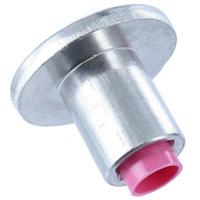Aluminum Survey Markers for Rebar
Our aluminum property markers make for fast and easy installation, helping land surveyors lower costs in the field. These long-lasting survey caps are specially designed to hold tight when driven onto rebar, avoiding metal corrosion.
Aluminum Survey Markers that are Perfect for Land Surveying
Feedback from our customers told us that a good survey cap would not "wobble" when tapped on the rebar. Because the dimensions of rebar can fluctuate, it’s difficult to create a cap that will secure onto the rods without any issues. But Berntsen’s survey caps are an effective solution that won’t wobble.
Our aluminum rebar caps are a great option for surveyors who want a long-lasting, durable cap that will keep the area of boundary defined. The material is resistant to most environmental conditions. But we highly recommend our bronze survey markers in environments with high traffic or salty conditions.
Not sure which survey marker is right for your needs?
Contact us today!

Aluminum Survey Caps that won't Corrode
Because aluminum is less "noble" than steel, the flow of an electrical current from the aluminum (+) to the steel (-) would lead to corrosion in the anode (+) area and the cap would start to loosen quickly. Our aluminum survey markers contain SureGrip plastic insulators, which remove the metal-to-metal contact of the rebar and cap that would otherwise cause dis-similar metal corrosion.
Plus, our caps offer a better design than a simple tapered cone socket. We use a deep hex socket that allows the plastic insert to expand to the different widths of the rebar, creating a super-tight compression fit.
6000 Series Aluminum
The 6000 series is an aluminum alloy family that contains magnesium and silicon as predominant alloying components. The remarkable properties of 6000 alloys are:
- High corrosion resistance
- Extrudability
- Excellent strength
- An ability to be thermally treated, enhancing their strength properties
The aluminum alloy in our survey corner markers is significantly stronger than other manufacturers that use 99% pure aluminum.Unlike other markers that are cast, pressed, or attached together with multiple material segments, Berntsen metal property markers are produced from our unique orbital forged process that forges one slug of aluminum to the shape of the cap. This helps increase the durability of the cap.
The 6000 series aluminum used in Berntsen survey markers is the same alloy family used for the rods in our rotating rod monument system. When rods are driven to refusal, they have to be super tough.
How to install Berntsen Survey Markers
1. Cut the rebar to the desired length and remove any burrs or mushrooming of ends.
2. Place a guide mark about 1.5” from the end of the rebar, using a felt tip permanent marker.
3. Drive the rebar to the desired length with the help of a rebar driver.
4. Clamp vice grip pliers onto the rebar at ground level.
5. Tap the rebar cap with a Lixie Hammer.
For more details about using Berntsen survey rebar caps, view our installation instructions here.